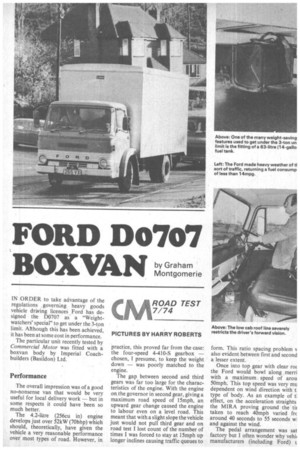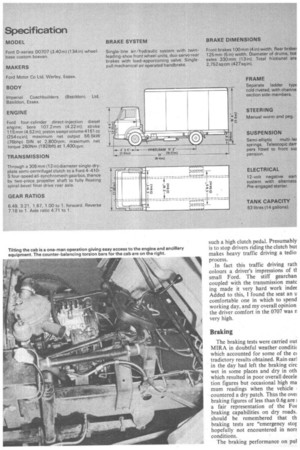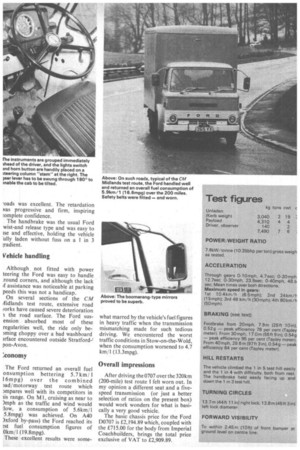FORD D0707 BOXVAN
Page 31

Page 32

Page 33

If you've noticed an error in this article please click here to report it so we can fix it.
by Graham Montgomerie
ITN TEST
PICTURES BY HARRY ROBERTS IN OR DER to take advantage of the regulations , governing heavy goods vehicle driving licences Ford has designed the 1)0707 as a "Weightwatchers' special" to get under the 3-ton limit. Atthough this has been achieved, it has been at some cost in performance.
The particular unit recently tested by Commercial Motor was fitted with a boxvan body by Imperial Coachbuilders (Basildon) Ltd.
Performance
The overall impression was of a good no-nonsense van that would be very useful for local delivery work — but in some respects it could have been so much better.
The 4,2-litre (256eu in) engine develops just over 52kW (70bhp) which should, theoretically, have given the vehicle a very reasonable performance over most types of road. However, in practice, this proved far from the case: the four-speed 4-410-S gearbox — chosen, I presume, to keep the weight down — was poorly matched to the engine.
The gap between second and third gears was far too large for the characteristics of the engine. With the engine on the governor in second gear, giving a maximum road speed of 15mph, an upward gear change caused the engine to labour even on a level road. This meant that with a slight slope the vehicle just would not pull third gear and on road test I lost count of the number of times I was forced to stay at 15mph up longer inclines causing traffic queues to form. This ratio spacing problem also evident between first and second a lesser extent.
Once into top gear with clear rot the Ford would bowl along merri with a maximum. speed of arou 50mph. This top speed was very mu dependent on wind direction with t. type of body. As an example of ti effect, on the acceleration straights the MIRA proving ground the th taken to reach 40mph varied frc around 40 seconds to 55 seconds wi and against the wind.
The pedal arrangement was sat factory but I often wonder why vehi manufacturers (including Ford) such a high clutch pedal. Presumably is to stop drivers riding the clutch but makes heavy traffic driving a tedio process.
In fact this traffic driving rath colours a driver's impressions of ti small Ford. The stiff gearchan coupled' with the transmission matc ing made it very hard work indee Added to this, I found the seat an u comfortable one in which to spend working day, and my overall opinion the driver comfort in the 0707 was r very high.
Braking
The braking tests were carried out MIRA in doubtful weather conditit which accounted for some of the ci tradictory results obtained. Rain ear] in the day had left the braking circ wet in some places and dry in oth which resulted in poor overall decele tion figures but occasional high ma mum readings when the vehicle countered a dry patch. Thus the ovei braking figures of less than 0.6g are a fair representation of the Fot braking capabilities on dry roads. should be remembered that th braking tests are "emergency stor hopefully not encountered in non' conditions.
The braking performance on pul .oads was excellent. The retardation vas progressive and firm, inspiring :omplete confidence.
The handbrake was the usual Ford wist-and release type and was easy to tse and effective, holding the vehicle ully laden without fuss on a 1 in 3 Tadient.
Vehicle handling
Although not fitted with power teering the Ford was easy to handle round corners, and although the lack if assistance was noticeable at parking peeds this was not a handicap.
On several sections of the CM rlidlands test route, extensive road iorks have caused severe deterioration the road surface. The Ford susension absorbed most of these regularities well, the ride only beming choppy over a bad washboard trface encountered outside Stratford-' pon-Avon.
.conomy
The Ford returned an overall fuel onsumption bettering 5.7 km/ 1 16mpg) over the combined )ad/ motorway test route which )mpares well with its competitors in us range. On Ml, cruising as near to )mph as the traffic and wind would 'low, a consumption of 5.6km/1 5.8mpg) was achieved. On A40 )xford by-pass) the Ford reached its ?...st fuel consumption figures of 0km/1 (19.8mpg).
These excellent results were some what marred by the vehicle's fuel figures in heavy traffic when the transmission mismatching made for such tedious driving. We encountered the worst traffic conditions in Stow-on-the-Wold, when the consumption worsened to 4.7 km/1 (13.3mpg).
Overall impressions
After driving the 0707 over the 320km (200-mile) test route I felt worn out. In my opinion a different seat and a fivespeed transmission (or just a better selection of ratios on the present box) would work wonders for what is basically a very good vehicle.
The basic chassis price for the Ford 1)0707 is E2,194.89 which, coupled with the £715.00 for the body from Imperial Coachbuilders, brings the total price exclusive of VAT to £2,909.89.




























































































